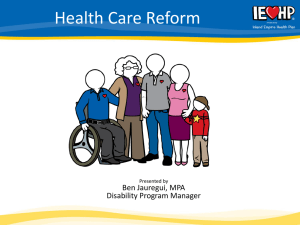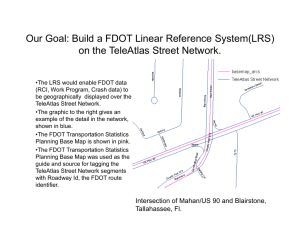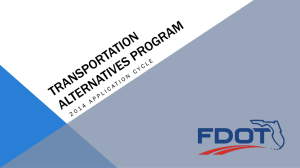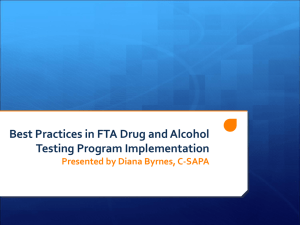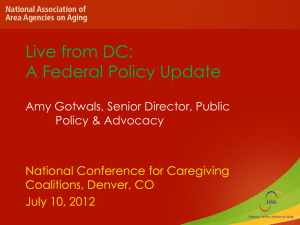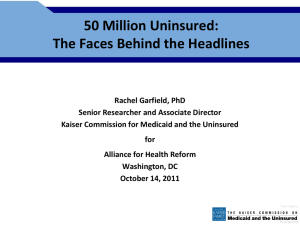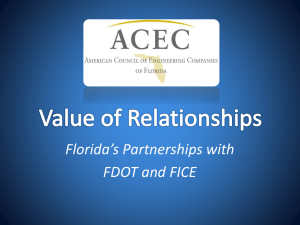The Growing Sound Barrier Wall Problem...A Case Study
advertisement
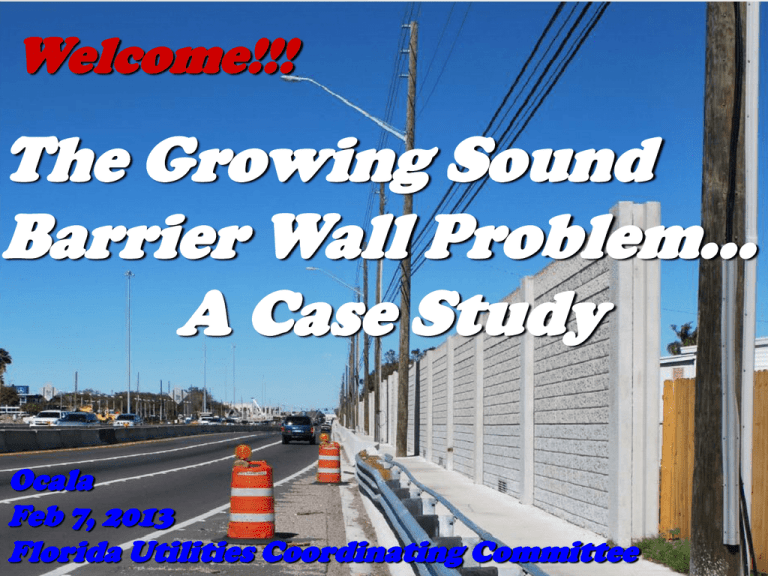
Welcome!!! The Growing Sound Barrier Wall Problem… A Case Study Ocala Feb 7, 2013 Florida Utilities Coordinating Committee 1 Discussion Objectives… • Why utilities in public rights-of-way, anyway? • Understand the need to work together to solve the problem; • Review a Case Study (i.e. illustrate the nature of the problem through eyes of an ongoing “live” project); • What can FDOT do to help? to help us get there… 2 Panel Members… US-41 Expansion Project Jordan Cook – FPL Deb Corbin – CenturyLink FUCC Sound Barrier Wall Task Team Joel Chatham, Art Gilmore – Progress Energy Florida; Chad Swails – Gulf Power; Bryan Lantz – Verizon Robert Lowen – AT&T; Henry Bowlin – CenturyLink Adam Padgett – TECO; Kris Hayes – Lakeland Electric David Kuhlman – FPL and…You All !!! 3 Why utilities in public rights-of-way, anyway? 23 CFR 645.209(a) “Utilities provide an essential public service to the general public. Traditionally, as a matter of sound economic public policy and law, utilities have used public road right-of-way for transmitting and distributing their services.” Program Guide Utility Relocation and Accommodation on Federal-Aid Highway Projects (Sixth Edition, Jan 2003) Utility Accommodation (Chapter 2): “It is recognized to be in the public interest for utility facilities to jointly use the right-of-way of public roads and streets when such use does not interfere with primary highway purposes. The opportunity for such joint use avoids the additional cost of acquiring separate right-of-way 4 for the exclusive accommodation of utilities.” What if all those utilities were in easements adjacent to R/W (instead of within the R/W)? •Those utility relocations would be reimbursable (not just occasionally, as they are now) •Gov’t Agencies might have to replace all those easements before commencing their road projects •Much more time required for road projects •Higher utility bills, higher road project costs •In general, just not very efficient 5 In Florida… F.S. 337.401 authorizes FDOT and local gov’t agencies to prescribe and enforce reasonable rules and regulations with respect to placement and maintenance of utility facilities within public rightsof-way (and publicly owned rail corridors). F.S. 337.403 requires utilities in return for that privilege to relocate at their own expense when unreasonably interfering with certain road (or rail corridor) improvements and operations. 6 So, what does all that mean… We need to work together, to the very best of our collective abilities, toward common sense “holistic” solutions that represent good public policy for the citizens of Florida, the same utility rate paying and tax paying citizens we all serve. 7 Sound Barrier Walls - a Growing Problem… a chronology of recent events: • FUCC member requests Sound Wall issue to be addressed at FUCC meeting • May 2, 2012 – FUCC Workshop “Understanding Sound Barrier Walls” • Examples of Good, and not so Good, Installations • FDOT’s Decision Making Process • Construction and Design Alternatives • Identify Potential Improvement Opportunities • Suggestion to write “Bold and Innovative Ideas” letter to FDOT Secretary Prasad • August 27, 2012 – FUCC submits that letter • Sept 21, 2012 – FDOT responds to FUCC letter 8 Sound Barrier Walls… chronology (cont): • Nov 6, 2012 – FUCC leadership meets with FDOT Senior Management in Tallahassee • FDOT commits to working with FUCC to resolve utility issues • FDOT requests FUCC’s top ten utility issues • Nov 8, 2012 – Tom Bane answers FUCC questions regarding FDOT response to FUCC letter • Nov 8, 2012 – FUCC identifies and unanimously approves Sound Barrier Walls to be named “Number One” issue, and establishes Sound Wall Task Team the following day 9 Sound Barrier Walls – A Case Study… • Illustrate pain felt on both sides • No intent to point fingers • No intent to mischaracterize • What can be done, other than business as usual, to help mitigate the problem US – 41 (SR 90) FPID 415621-2-52-01 •add lanes and reconstruct (approx 3.4 miles) •from two lanes to 6 lane, divided July 12, 2011 – First utility design meeting (pre-design conference) attended by FPL - 30% plans, no wall shown, noise impact study not yet complete. FPL explains that Sound Wall on south side would require “significant” FPL relocation work. April 2012 – FPL receives 60% plans which show potential sound wall on roadway plan sheets (but no details. height, footer, etc) 10 Case Study (cont)… May 8, 2012 – FPL informed at phase 2 utility design meeting that wall was no longer potential, but would be installed. FPL again indicated this would require significant relocation work. May 8, 2012 – as result of May FUCC presentation, FPL requests alternative construction info from vendor (vendor refuses to help without being paid) Initial discussions devoted to relocating/adjusting pole line to accommodate 16 ft. wall on gravity wall, (20 ft on backside due to grade difference) 4 ft. from R/W edge, in front of pole line– FPL expresses concern that 50’ – 55’ poles will be required, which if behind the wall, would be inaccessible after wall’s completion (Suggestions also made that perhaps these power lines should be buried, or removed from the r/w altogether.) 11 12 13 14 15 Case Study (cont)… June 15, 2012 – FPL requests that cost of relocating 1 mile of pole line be used to possibly justify removing the wall from project. June 18, 2012 – “Draft” Noise Study Executive Summary (dated June 13, 2012) returned identifying two sections where “noise abatement was determined to be potentially feasible and cost reasonable.” The summary affirmed that a “detailed public involvement program had been carried out to ensure that the viewpoints of the impacted public regarding the barriers had been considered…” The summary “recommended” a particular sound wall (with detailed description) to be built. June 26, 2012 – FPL requests FDOT to consider FPL’s estimated cost to relocate in the “cost reasonableness” determination. June 27, 2012 - FDOT responds that the cost reasonableness guidelines are determined by the Central Office. June 28, 2012 – FPL asks if aside from the guideline utility costs may not be included, is there any other opportunity for FDOT to decide against building the wall in conflict with the pole line. 16 Case Study (cont)… June 28, 2012 – FDOT responds that since wall meets all criteria set by Central Office, FDOT must continue forward with current design of wall, followed by a separate assertion the guidelines are actually set by FHWA. June 29, 2012 – Accepting that FDOT will not remove wall from project, FPL requests the design to allow for pole line to remain on the “road” side of the wall, so it can remain accessible. August 1, 2012 – Utilities notified of August 31 UWS “drop dead” date. FPL unable to comply since conflict not yet resolved. October 26, 2012 – FDOT tells FPL that placement of FPL poles on roadside of wall not feasible, and suggests FPL’s pole line be moved to opposite side of the road. January 9, 2013 – FPL conflict still unresolved, FDOT announces the project going Design Build with August 2013 Bid Opening Date. 17 Case Study (cont)… January 10, 2013 – FPL requests that RFP include the requirement that project be designed so FPL’s pole line can remain on same side of road, on the road side of the wall, with wall designed to reasonably minimize need for adjustment and de-energize. Feb 7, 2013 – So here we are… Questions? Comments? 18 In Conclusion… 23 CFR 772.9(a) provides that “The highway agency shall determine and analyze expected traffic noise impacts and alternative noise abatement measures to mitigate these impacts, giving weight to the benefits and cost of abatement, and to the overall social, economic and environmental effects.” F.S. 335.17 requires all projects by the department to be developed in conformity with federal standards for noise abatement as contained in 23 CFR 772. Question… 19 What can FDOT do to help mitigate the burden that sound walls are creating for utility installations within public R/W? - Within current statutory/rule environment? - Through (Florida) statutory/rule change? - Through the FHWA? Answers will help our FUCC Sound Wall Task Team decide how best to proceed… 20
